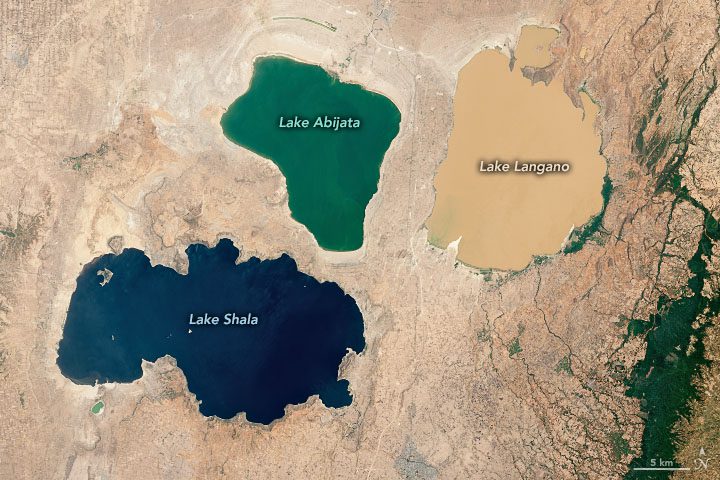Around 2,000 years ago, three entirely different bodies of water were formed from one ancient Ethiopian lake splitting apart. Through a process of tectonic activity and changing rainfall patterns, the large Lake Galla disappeared, and in its place stood Lake Shala, Lake Abijata, and Lake Langando — three siblings that don’t even look related. So, how did these lakes come to be such different colors?
There are a number of factors that contribute to the colorful displays seen in bodies of water. Minerals are a common cause of changing water color, but lakes can also be affected by soil runoff, sediment, algae, and sometimes just our eyes.
Over time, water can cause rocks to weather, breaking apart and dissolving the minerals released from the stones’ surface. Different colors can come as a result of different types of minerals found in the stone surrounding the lakes. Ranges of red to green are commonly created by iron, magnesium, and calcium carbonate released from limestone.
Lakes Shala, Abijata and Langano, which all once made up Lake Galla, Ethiopia. Image credit: NASA Earth Observatory
Of the Galla Lakes, Lake Abijata receives runoff from the Bulbula River, which crosses a lava sill before depositing soft sediment in its waters. Lake Langano’s color is transformed by fine red sediment, which creates a murky brown hue. While Lake Shala gets its deep blue color from its vast depth, which in places exceeds 260 meters (850 feet).
However, the variety seen in the Galla Lakes is comparatively tame compared to the rainbow displays seen on those lakes that are affected by bacteria and algae.
The Grand Prismatic Spring, Yellowstone National Park, USA. Image credit: Lorcel / Shutterstock
The Grand Prismatic Spring in Yellowstone National Park is arguably one of the best-known, and best-looking, water features. The colorful layered effect seen on the outer rings of the hot spring is produced by a heat-loving bacteria, while its deep blue center is purely a result of how we perceive blue wavelengths of light.
Lake Retba, Senegal. Image credit: Anton_Ivanov / Shutterstock
Relying on living organisms to maintain your flashy displays can, however, be temperamental. Lake Retba in Senegal gets its rosy hue from a protective beta carotene produced by the algae living within its waters. The organisms produce this pigment as a form of protection from the harsh salty conditions of the lake. But during rainy season, the freshly diluted water is no longer considered harsh, and the algae stop producing the brilliant red pigment.
Lake Hillier in Western Australia. Image credit: Matteo_it/Shutterstock.com
Australia famously has many pink lakes, as does Mexico, India, and as already seen, Senegal. Mostly found in Western and Southern Australia, they are also caused by bacteria and algae that thrive in super salty bodies of water, which these Australian icons are. Carotenoid red pigments secreted by Halobacteria and algae called Dunaliella salina give them their color. While most of Australia’s pink lakes are seasonally dependent, Lake Hillier in Western Australia stays pink all year round.
Lake Natron, Tanzania. Image credit: Danita Delimont / Shutterstock
While these radiant lakes may look inviting, in some cases it’s best to admire them from afar. Lake Natron in Tanzania is the most caustic body of water in the world. While it might not turn you to stone, it is considered a soda lake and has a pH of almost 12. Despite its threatening red hue, it’s not the caustic conditions that cause the discoloration, it is instead the presence of a salt-loving microorganism called Spirulina, which produces red, pink, and orange pigments.
The temperamental and ever-changing conditions of Earth’s surface has resulted in entirely unique formations of lakes all over the world, and as climate change continues to progress, so do the appearances of these large and iconic bodies of water.
Source Link: Why Do Lakes Come In So Many Colors?
